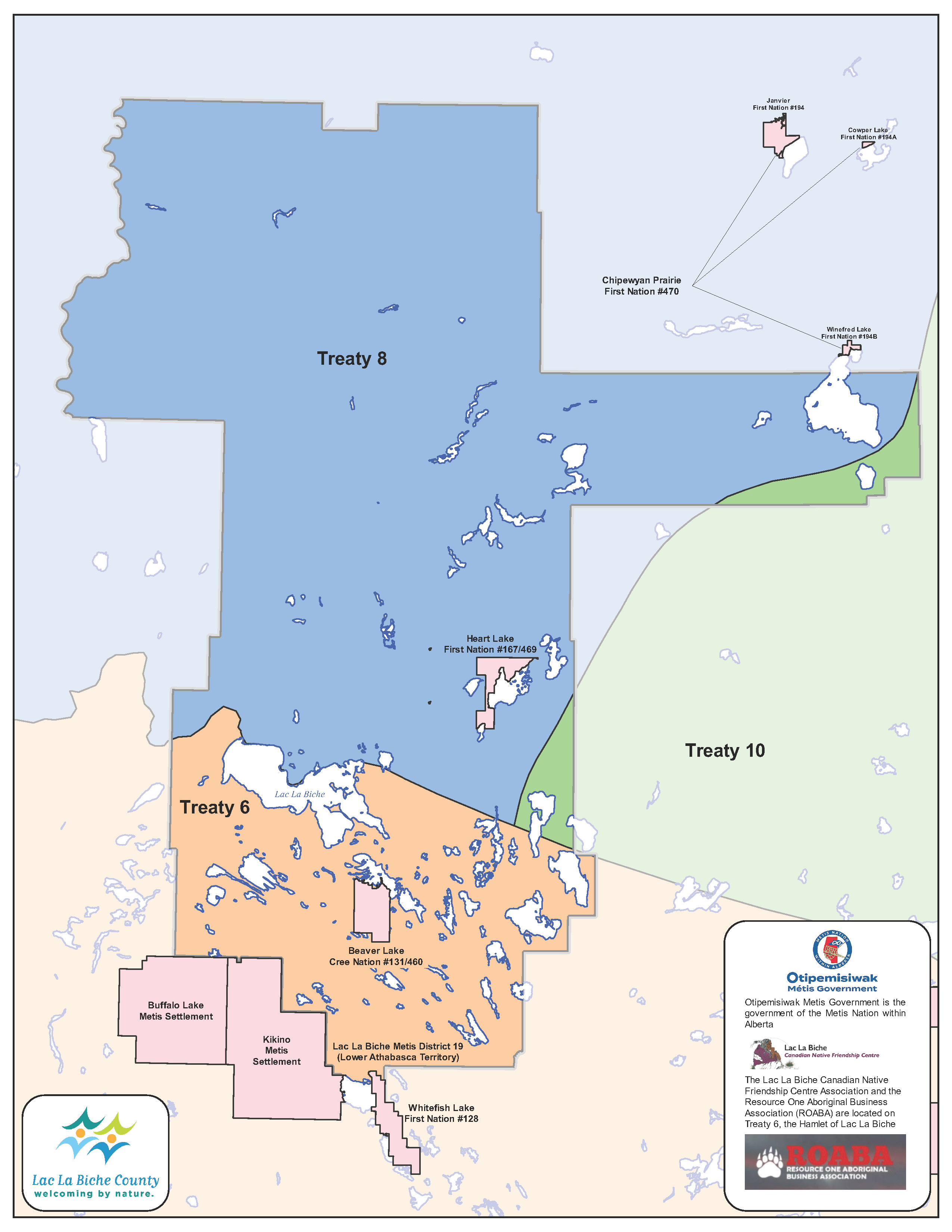Lac La Biche County's context
Lac La Biche County is uniquely situated on the lands of three different Treaties between Indigenous and non-Indigenous peoples, as well as Region One of the Métis Nation of Alberta. The County directly neighbours three First Nations (Beaver Lake Cree Nation, Heart Lake First Nation and Whitefish Lake First Nation) and two Alberta Métis Settlements (Buffalo Lake Métis Settlement and Kikino Métis Settlement). We are home to a high number of Indigenous residents and several Indigenous-led businesses and organizations, including tourism operators who provide Indigenous cultural experiences and learning opportunities for visitors.

Land Acknowledgement
Lac La Biche County's Land Acknowledgement was officially adopted in 2022, following engagement with Indigenous communities, organizations and individuals. We would like to thank the Indigenous partners who helped us take this important step on the path towards true reconciliation, and we are proud to have our Land Acknowledgement available in regional Indigenous languages. Click here to read our official Land Acknowledgement Guidelines.
ENGLISH
We respectfully acknowledge the traditional and ancestral lands of the First Nations peoples of Treaty 6, Treaty 8 and Treaty 10 territories and the Homeland of the Métis people. Lac La Biche County continues to be home to Indigenous peoples since time immemorial, and we recognize the vital contributions of Indigenous culture, history and perspectives in our shared past, present and future.
FRENCH
Nous reconnaissons respectueusement les terres traditionnelles et ancestrales des peuples des Premières Nations faisant partie des territoires visés par le Traité numéro 6, le Traité numéro 8 et le Traité numéro 10 ainsi que la terre natale des Métis. Le comté de Lac La Biche abrite les peuples autochtones depuis des temps immémoriaux, et nous reconnaissons l’apport essentiel de la culture, de l’histoire et des perspectives autochtones à notre passé, notre présent et notre avenir collectifs.
CREE - Translation provided by Lac La Biche Canadian Native Friendship Centre
Nimanācitānān naskwēyasihtamōwin nēhīyaw ōtipamakan askiya ēkwa ōtipimiso askiy. Wāwāskēsiw sākahikanihk kiyāpic nēhīyaw isiyiniw ēwīkiw aspin ohci kakiskisihk ēkwa nisitawēyitīnan nēhīyaw kayas pimacihowin ēkwa ēwāpatamahk asonamātōwin pīci ōtahk, anohc mēkwac, ēkwa ōtīnīkan.
NORTHERN MICHIF - Translation provided by Métis Knowledge Holder Sky Blue Morin
Neyanân meyo totumakew’iyahk nusk’wesihtâmayhk anihi kayâs ochi kâkê itotumihk mêna wâhkomâkunak uskêa ochi First Nations âyisêniwahk ochi Treaty 6, Treaty 8 mêna Treaty 10 ooma uskêkana mêna anima Neginân’uskê ochi li Metis âyisêniwak. Lac La Biche County âhkume’yihta neginân kichi Indigenous âyisêniwak isko kêsikâw tipahikun namoya wekâch pooni’payiw, mêna neyanân nistâwi’namahk anihi kêchi’towun pukitinih’towina ochi Indigenous kayâs’pimâtsowin, kayâs’âchimowin mêna meskwêhtu’mowina oma keyanâw pâhkwe’numawewin kayâs’ochi, âyâw mekwach mêna nekân ote.
DENE - Translation coming soon
Indigenous Collaboration Committee
Lac La Biche County's Indigenous Collaboration Committee exists to strengthen communication and relationships with neighbouring Indigenous communities and local and regional Indigenous-led organizations.
The committee serves in an advisory capacity to Lac La Biche County Council. Please click here to read the committee terms of reference.
Facebook